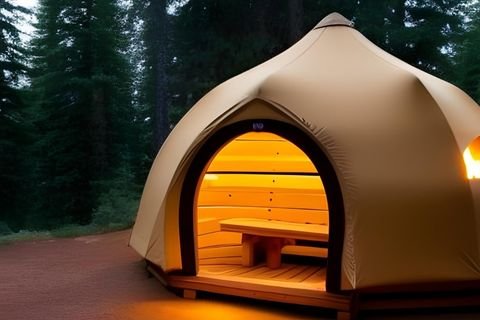Introduction
Heat therapy has long been used to promote human wellness because it has so many positive psychological and physical effects. Sweat lodges VS saunas are two of the more well-liked heat therapy options out there.
Both have unique characteristics, customs, and health advantages. We will delve into the world of sweat lodges and saunas in this thorough comparison, examining their histories, differences, and potential benefits.
A Glimpse into Sweat Lodges
The Old Tradition
In Native American and indigenous cultures all over the world, sweat lodges have a long history. These ancient buildings typically consist of a small, enclosed area that is covered in blankets or hides and constructed out of organic materials like wood. There is a pit or fire pit in the middle where heated stones are positioned. Herbal-infused water is poured onto the stones, causing steam to form and raising the lodge’s temperature.
Ritual and Ceremony
Sweat lodge sessions often include ritualistic and ceremonial components, making them both a spiritual and physical experience. The group forms a circle and enters the lodge one at a time. A leader or shaman oversees the ceremony, sets intentions, and fosters a sacred environment throughout the experience.
Heat and Healing
A sweat lodge’s extreme heat causes heavy sweating, which is thought to help the body rid itself of toxins. Numerous participants also mention stress relief and a sense of spiritual connection as additional benefits for their minds and hearts. Sweat lodge rituals are frequently used for healing, spiritual development, and purification.
Saunas: The Modern Heated Retreat

A Finnish Invention
On the other hand, saunas originated in Finland and have gained popularity throughout the world. These buildings are typically constructed of wood and furnished with heating appliances like electric or wood-burning stoves. Dry heat is used in saunas, and the temperature can change depending on the user.
Accessibility and Popularity
Saunas, as opposed to sweat lodges, are now widely available in health clubs, spas, and private homes. Their widespread popularity has been influenced by their simplicity of use and capacity for humidity and temperature control. Saunas are frequently connected to socialization, stress reduction, and relaxation.
Health and Wellness
The health benefits of saunas are well-documented. Regular sauna sessions are believed to improve cardiovascular health, aid in detoxification, and enhance mental well-being. Sauna enthusiasts appreciate the convenience of incorporating this practice into their daily routine.
Key Differences
Heat Source and Humidity
The heat source and humidity level are the two main distinctions between sweat lodges and saunas. Sweat lodges use steam to create a high-humidity environment by pouring water over heated stones. Saunas, on the other hand, use dry heat, which is produced by electric heaters or wood-burning stoves.
Temperature Control
The ability to control temperature is yet another notable difference. Users of saunas can set the temperature precisely to their preferred level of comfort. The size of the fire and the amount of water that is poured onto the stones in sweat lodges are the main factors that control the temperature, making it less precise and potentially more intense.
Tradition vs. Modernity
Ancient rituals such as sweat lodges frequently involve spiritual or ceremonial elements. Despite having a long cultural history, modern relaxation and wellness practices are more frequently linked to saunas.
Accessibility
Compared to sweat lodges, saunas are more prevalent and simpler to locate. Saunas can be found in hotels, spas, gyms, and even in private homes. Sweat lodges, on the other hand, are less accessible to the general public because they are frequently connected to specific ceremonies or retreats.
Social vs. Individual Experience
People frequently gather with friends or family to unwind and chat in saunas as a social activity. While sweat lodges can be social, they are frequently used during ceremonies alone or in smaller, more private groups.
Health Benefits
While both saunas and sweat lodges have a variety of potential health advantages, their different heat sources and environments have an impact on how these advantages work.
Sweat Lodge Benefits
- Detoxification: The high humidity and profuse sweating in sweat lodges are believed to aid in detoxification by promoting the release of toxins through sweat.
- Spiritual and Emotional Well-being: Many participants report a sense of spiritual connection, emotional release, and personal growth during sweat lodge ceremonies.
- Respiratory Benefits: Inhaling steam with herbal infusions in sweat lodges can have potential respiratory benefits for some individuals.
Sauna Benefits
- Improved Cardiovascular Health: Regular sauna use has been linked to improved circulation, lower blood pressure, and reduced risk of cardiovascular diseases.
- Stress Reduction: Sauna sessions promote relaxation, reduce stress hormones, and enhance mental well-being.
- Muscle Relaxation: Dry heat in saunas can help relieve muscle tension and soreness, making them popular among athletes.
- Skin Health: Saunas can improve skin health by promoting circulation and helping to clear clogged pores through sweating.
Making a choice: Sweat Lodge or Sauna
The choice between a sweat lodge and a sauna ultimately depends on your preferences, goals, and access to these facilities. Here are some factors to consider when deciding which heat therapy practice is right for you:

1. Tradition and Culture
A sweat lodge might be a better option if you value the spiritual and cultural benefits of heat therapy and want a more conventional experience. It may enable a closer connection to customs and rituals from the past.
2. Accessibility
Saunas are widely accessible and available in a lot of spas, wellness centers, and gyms if convenience and accessibility are important to you. Additionally, you can put in a sauna in your house for regular use.
3. Health Goals
Take into account your unique health and wellness objectives. Do you want to relax, detoxify, or connect with your spiritual side more than anything else? Knowing your goals will enable you to select the best course of action.
4. Personal Comfort
Consider how much heat, humidity, and the overall experience you can take. Others prefer the steamy environment of sweat lodges, while some prefer the dry heat of saunas.
5. Safety and Precautions
Be aware of any underlying medical conditions and your physical health. Before using heat therapy, always speak with a medical professional, especially if you are worried about how it might affect your health.
Conclusion
Both sweat lodge vs sauna are effective heat therapy techniques that provide a variety of physiological and psychological advantages. Despite their differences in tradition, heat source, and setting, they all aim to encourage relaxation and well-being.
The decision between a sweat lodge and vs sauna ultimately comes down to individual preferences and objectives. In the world of heat therapy, both traditional, spiritually enlightening experiences and contemporary, easily accessible forms of relaxation have their place. Whatever you decide, it’s important to approach these practices mindfully, with respect for tradition, and with a dedication to your own health and well-being.
What is the difference between a sweat lodge and a sauna?
The difference between the two is that while many people spend hours in a sweat lodge, most people keep their sauna sessions to twenty minutes. In a few rare instances, this has resulted in dehydration and heat exhaustion deaths! Stones are heated in a similar manner, then water is poured over them to produce steam.
Are sweat lodges healthy?
They can be dome-shaped or tepee-like permanent or transportable structures where steam is produced by pouring water over hot rocks. Health Risks: Due to prolonged exposure to high temperatures in a small space, using sweat lodges has the potential to be dangerous.
Are sweat lodges hot?
A sweat lodge gets how hot? While the temperature can differ from one sweat lodge to the next, it can get very warm inside. The temperature inside a sweat lodge can range from 100 to 120 degrees, depending on the ceremony leader’s personal preferences.










[…] the quest for sore throat relief, saunas emerge as a unique and potentially beneficial remedy. While the scientific evidence connecting saunas directly to sore throat relief is not exhaustive, […]